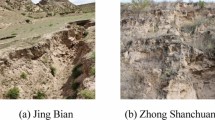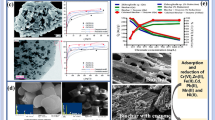Abstract
Mono-potassium phosphate (MKP), natural phosphate fertilizer, and red mud (RM) were tested individually and as mixed agents for stabilizing Cd, Pb, and Zn in mine tailings. The mixed stabilizer containing MKP/RM was the most effective among the tested stabilizers. This is based on the efficiency of conversion from the plant-available metal fractions to the non-plant-available metal fractions and on the performances of toxicity characteristic leaching procedure tests. MKP/RM converted Cd and Zn mainly to carbonate and Fe/Mn oxide fractions, and Pb mainly to the residual fraction. When the mine tailings were treated with MKP/RM, the pH value of the stabilized soil increased from 3.4 to 6.4 after 28 days, which is advantageous for plant growth. The X-ray diffraction, scanning electron microscopy/energy dispersive spectroscopy, and the sequential extraction results imply that the major stabilization mechanism for Cd and Zn by MKP and RM involves the formation of surface complexes with Fe (hydr)oxides or Fe phosphates. The major stabilization mechanism of Pb by MKP is believed to involve the formation of Pb-phosphate precipitates, and that by RM is proposed to involve the formation of inner sphere complexes with Fe/Al (hydr)oxides or incorporation within the grids of Fe/Al (hydr)oxides or silicate minerals.





Similar content being viewed by others
References
Alloway BJ, Jackson AP, Morgan H (1990) The accumulation of cadmium by vegetables grown on soils contaminated from a variety of sources. Sci Total Environ 91:223–236
Apak R, Tutem E, Hugul M, Hizal J (1998) Heavy metal cation retention by unconventional sorbents (red muds and fly ashes). Water Res 32(2):430–440
Brown S, Christensen B, Lombi E, McLaughlin M, McGrath S, Colpaert J, Vangronsveld J (2005) An inter-laboratory study to test the ability of amendments to reduce the availability of Cd, Pb, and Zn in situ. Environ Pollut 138(1):34–45
Brunori C, Cremisini C, Massanisso P, Pinto V, Torricelli L (2005) Reuse of treated red mud bauxite waste: studies on environmental compatibility. J Hazard Mater 117(1):55–63
Chen M, Ma LQ, Singh SP, Cao RX, Melamed R (2003) Field demonstration of in situ immobilization of soil Pb using P amendments. Adv Env Res 8(1):93–102
Conner JR (1990) Chemical fixation and solidification of hazardous wastes. Van Nostrand Reinhold, New York
Devau N, Le Cadre E, Hinsinger P, Jaillard B, Gerard F (2009) Soil ph controls the environmental availability of phosphorus: experimental and mechanistic modeling approaches. Appl Geochem 24(11):2163–2174
Dominguez MI, Carpena J, Borschnek D, Centeno MA, Odriozola JA, Rose J (2008) Apatite and Portland/apatite composite cements obtained using a hydrothermal method for retaining heavy metals. J Hazard Mater 150(1):99–108
Gupta VK, Sharma S (2002) Removal of cadmium and zinc from aqueous solutions using red mud. Environ Sci Technol 36(16):3612–3617
Gupta KA, Sinha S (2006) Chemical fractionation and heavy metal accumulation in the plant of Sesamum indicum (L.) var. T55 grown on soil amended with tannery sludge: selection of single extractants. Chemosphere 64(1):161–173
Hinsinger P (2001) Bioavailability of soil inorganic P in the rhizosphere as affected by root-induced chemical changes: a review. Plant Soil 237:173–195
Hsu OH (1965) Fixation of phosphate by aluminum and iron in acidic soil. Soil Sci 99(6):398–402
Kashem MA, Singh BR, Kondo T, Imamul Huq SM, Kawai S (2007) Comparison of extractability of Cd, Cu, Pb and Zn with sequential extraction in contaminated and non-contaminated soils. Int J Environ Sci Tech 4(2):169–176
Krebs R, Bupta SK, Furrer G, Schulin R (1998) Solubility and uptake of metals with and without liming of sludge amended soils. J Environ Qual 27(1):18–23
Kumpiene J, Lagerkvist A, Maurice C (2008) Stabilization of As, Cr, Cu, Pb and Zn in soil using amendments––a review. Waste Manag 28(1):215–225
Kundu S, Gupta AK (2008) Immobilization and leaching characteristics of arsenic from cement and/or lime solidified/stabilized spent adsorbent containing arsenic. J Hazard Mater 153(1/2):434–443
Lombi E, Hamon RE, Mcgrath SP, Mclaughlin MJ (2003) Lability of Cd, Cu, and Zn in polluted soils treated with lime, beringite, and red mud and identification of a non-labile colloidal fraction of metals using isotopic techniques. Environ Sci Technol 37(5):979–984
Ma Y, Lin C, Jiang Y, Lu W, Si C, Liu Y (2009) Competitive removal of water-borne copper, zinc and cadmium by a CaCO3-dominated red mud. J Hazard Mater 172(2/3):1288–1296
Matusik J, Bajda T, Manecki M (2008) Immobilization of aqueous cadmium by addition of phosphates. J Hazard Mater 152(3):1332–1339
Melamed R, Cao X, Chen M, Ma LQ (2003) Field assessment of lead immobilization in a contaminated soil after phosphate application. Sci Total Environ 305(1/3):117–127
Moreno-Jimenez E, Penalosa JM, Manzano R, Carpena-Ruiz RO (2009) Heavy metals distribution in soils surrounding an abandoned mine in NW Madrid (Spain) and their transference to wild flora. J Hazard Mater 162(2/3):854–859
Naidu R, Harter RD (1998) Effect of different organic ligands on cadmium sorption by and extractability from soils. Soil Sci Soc Am J 62(3):644–650
Naidu R, Kookana RS, Summer ME, Harter RD, Tiller KG (1997) Cadmium sorption and transport in variable charge soils: a review. J Environ Qual 26(3):602–617
Ndiba PK, Axe L (2009) Metal speciation in phosphate and thermal stabilization of contaminated dredged sediments. In: Contemporary topics in ground modification, problem soils, and geo-support, pp 512–519. doi:10.1061/41023(337)65
Ownby DR, Galvan KA, Lydy MJ (2005) Lead and zinc bioavailability to Eisenia fetida after phosphorus amendment to repository soils. Environ Pollut 136(2):315–321
Qian J, Shan X, Wang Z, Tu Q (1996) Distribution and plant availability of heavy metals in different particle-size fractions of soil. Sci Total Environ 187(2):131–141
Santona L, Castaldi P, Melis P (2006) Evaluation of the interaction mechanisms between red mud and heavy metals. J Hazard Mater 136(2):324–329
Tessier A, Campbell PGC, Bisson M (1979) Sequential extraction procedure for the speciation of particulate trace metals. Anal Chem 51(7):844–851
USEPA (1992) Test methods for evaluating solid waste, physical/chemical methods, SW-846, 3rd ed., Method 1311, Toxicity Characteristic Leaching Procedure. Environmental Protection Agency, Washington, DC, USA
Weng L, Vega FA, Van Riemsdijk WH (2011) Competitive and synergistic effects in pH dependent phosphate adsorption in soil: LCD modeling. Environ Sci Technol 45(19):8420–8428
Wiegand J, Aschan G, Kraus U, Piontek J, Mederer J (2009) Chemical fractionation and soil-to-plant transfer characteristics of heavy metals in a sludge deposit field of the river Ruhr, Germany. Soil Sediment Contam 18(1):14–29. doi:10.1080/15320380802545217
Yi L, Hong Y, Wang D, Zhu Y (2010) Effect of red mud on the mobility of heavy metals in mining-contaminated soils. Chin J Geochem 29(2):191–196
Yukselen MA, Alpaslan B (2001) Leaching of metals from soil contaminated by mining activities. J Hazard Mater 87(1/3):289–300
Acknowledgments
This research was supported by the Unique Project (11-3411) of the Korea Institute of Geoscience and Mineral Resources (KIGAM) funded by the Ministry of Knowledge Economy of Korea.
Author information
Authors and Affiliations
Corresponding author
Rights and permissions
About this article
Cite this article
Ahn, JY., Kang, SH., Hwang, KY. et al. Evaluation of phosphate fertilizers and red mud in reducing plant availability of Cd, Pb, and Zn in mine tailings. Environ Earth Sci 74, 2659–2668 (2015). https://doi.org/10.1007/s12665-015-4286-x
Received:
Accepted:
Published:
Issue Date:
DOI: https://doi.org/10.1007/s12665-015-4286-x




